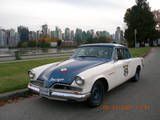When running my partial flow 289 at high RPMs (4,500 - 5,500) for extended periods oil sprays out the oil filler cap. Not huge amounts of oil, but enough to make a mess in the engine compartment. I think it is also a bit of a fire hazard. I have breather tubes on both valve covers, and a road draft tube, but I get the oil spray anyway.
To solve this problem could I put a removable cap (without the breather holes) on the oil filler tube, attach a fitting to the cap, and run a hose from the fitting to a small container that acts as a resevoir to catch the oil? The container would have a breather cap on it.
Does anyone see a problem with doing something like this?
John
1953 Commander Coupe
1954 Champion Sedan
1963 Lark

To solve this problem could I put a removable cap (without the breather holes) on the oil filler tube, attach a fitting to the cap, and run a hose from the fitting to a small container that acts as a resevoir to catch the oil? The container would have a breather cap on it.
Does anyone see a problem with doing something like this?
John
1953 Commander Coupe
1954 Champion Sedan
1963 Lark





Comment